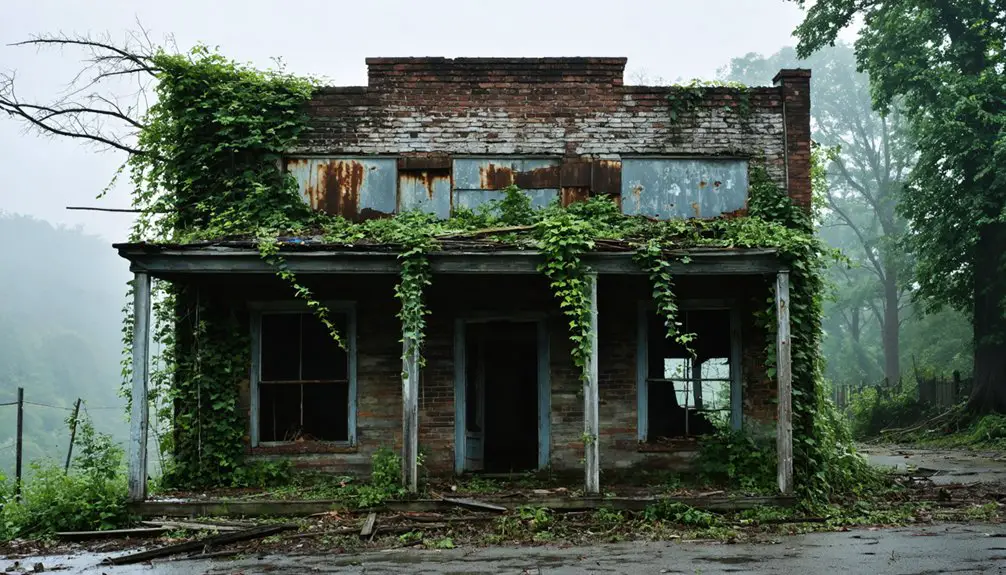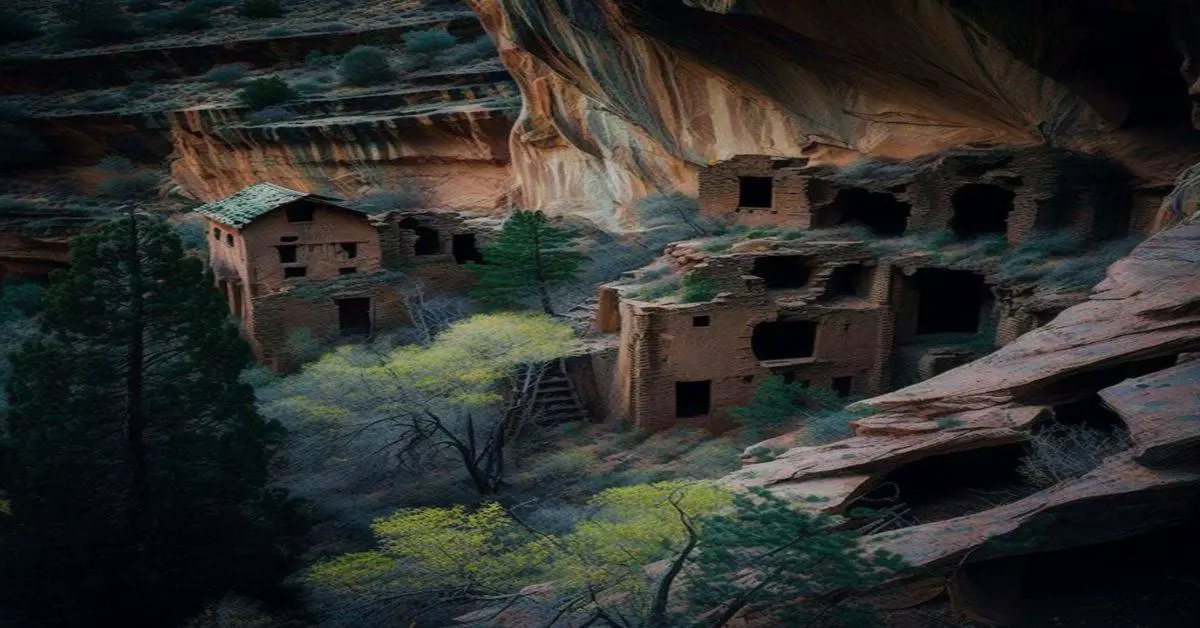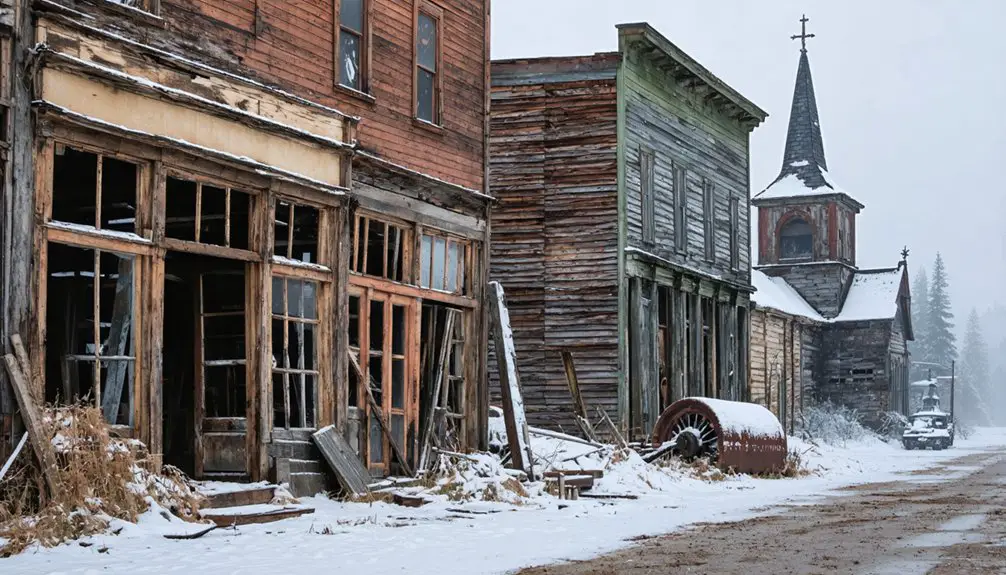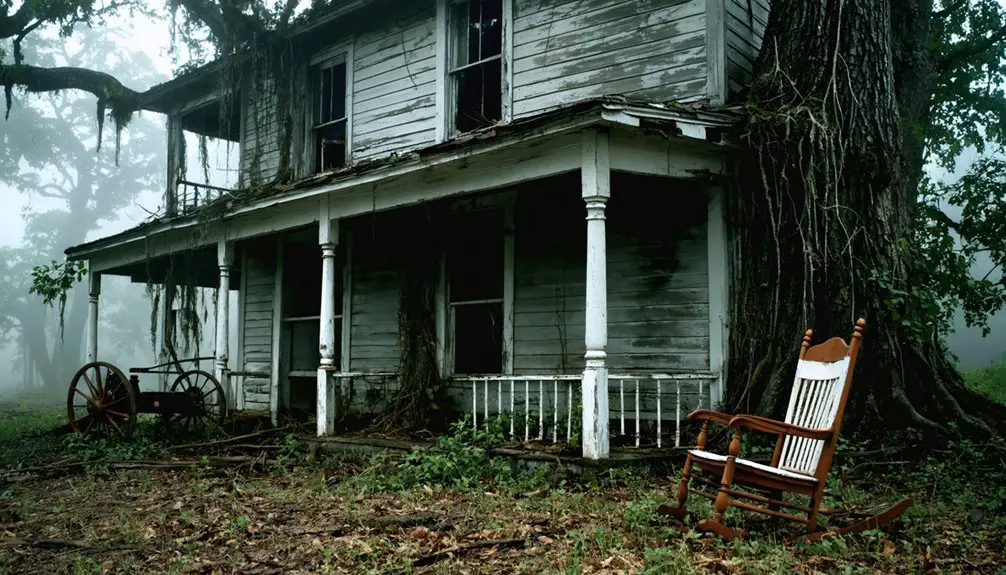You’ll find Lobelia tucked away off Route 219 in Pocahontas County, West Virginia, where a once-thriving coal mining community has surrendered to nature’s slow reclamation. The town emerged as a coal camp, with miners enduring grueling shifts and payment in company scrip. In the late 1960s, “Back to the Landers” arrived from urban areas, creating new social dynamics. Today, decaying buildings, moss-covered foundations, and hidden mining equipment tell deeper stories of Appalachian transformation.
Key Takeaways
- Lobelia began as a coal mining camp in Pocahontas County, West Virginia, located along a steep mountain road off Route 219.
- The town’s economy centered around coal mining operations, where workers endured harsh conditions and were paid in company scrip.
- Abandoned buildings and stone foundations are slowly being reclaimed by nature, with vines and vegetation overtaking the former structures.
- The surrounding Monongahela National Forest encompasses almost half the area, contributing to the ghost town’s isolation and preservation.
- The site witnessed a notorious 1980s murder case where Walter Smith’s body was discovered buried under rocks by local children.
The Rise and Fall of a Mountain Community
While many ghost towns in West Virginia emerged from the coal industry’s boom-and-bust cycle, Lobelia’s story stands apart due to its distinct phases of community evolution.
You’ll find its origins as a coal camp nestled along a steep mountain road off Route 219, where miners and their families carved out a living in Pocahontas County’s rugged terrain. Almost half of the surrounding area consists of the Monongahela National Forest, defining the remote character of the region.
The town’s most dramatic cultural shifts occurred in the late 1960s when “Back to the Landers” arrived from major cities, seeking an alternative lifestyle away from urban unrest.
In the turbulent 1960s, urban dwellers seeking escape found refuge in Lobelia, transforming this quiet mountain town’s cultural fabric forever.
These economic changes created complex social dynamics between longtime residents and newcomers. As mines closed and jobs disappeared, both groups struggled to maintain community cohesion. Much like Richwood’s decline, the town’s prosperity faded as the timber and mining industries slowed in the mid-1900s.
Life in the Coal Mining Era
You’d find life in Lobelia’s coal mines defined by grueling 10-12 hour workdays, where miners earned their wages through dangerous underground work amid constant threats of methane gas, roof collapses, and coal dust.
The mining company’s grip extended beyond the workplace, as they controlled the town’s housing, store credit, and social activities, creating a tight-knit but dependent community of workers and their families. Many miners were forced to purchase goods using company scrip at inflated prices from the company-owned stores. Immigrant laborers from Wales and Scotland often filled the demanding mining positions.
Your survival underground depended on staying alert to warning signs like creaking timber supports or the distinctive smell of gas, while following strict safety protocols that emerged after disasters like the 1886 Mountain Brook Mine explosion.
Mining Jobs and Wages
The coal mining industry in Lobelia offered five primary job types, each carrying distinct responsibilities and risks. You’d find miners extracting coal underground, tipple operators managing the coal processing, loaders filling train cars, and runners delivering supplies.
Mining employment often included boys working alongside their fathers in smaller family operations. By the early 1900s, nearly half a million workers were employed across American coalfields.
Your wages would’ve been paid in company scrip – private currency you could only spend at the company store. While today’s miners earn substantially more than average workers, Lobelia’s early miners faced significant wage disparities. To maintain control over miners’ spending, companies issued scrip in metal coin form to prevent counterfeiting.
You’d earn based on tons produced rather than hourly rates, and the company store’s inflated prices often consumed most of your earnings. The system kept miners financially dependent on the coal company, leading to frequent labor disputes and strikes.
Community Around the Mines
Deep in southern West Virginia’s coalfields, life in Lobelia revolved entirely around the company-owned mining town, where you’d find yourself living in a basic wood-frame house alongside other mining families.
You’d shop at the company store, often at inflated prices that kept you in constant debt. The community dynamics reflected a rich blend of European immigrants and African Americans who’d migrated north seeking better opportunities, creating a culturally diverse but economically unified neighborhood. Your wages were paid in company currency scrip, severely limiting your purchasing options outside the company store. The dangerous working conditions meant that yearly mining deaths were a constant reminder of the risks faced by the community.
Your social life would center around the local church, which served as both a spiritual refuge and community gathering place.
You’d form tight bonds with neighbors through shared hardships, while extended families lived close by for mutual support.
During labor disputes, you’d face the ever-present threat of eviction, making solidarity with fellow miners essential for survival.
Daily Hazards Underground
While families built their lives aboveground in Lobelia’s close-knit community, miners faced stark dangers every time they descended into the coal seams below.
You’d find yourself working in cramped, dimly lit spaces where the air grew thick with coal dust and toxic gases. Underground hazards lurked at every turn – from unexpected roof collapses to the constant threat of explosive methane gas.
Your daily routine meant confronting extreme temperatures, deafening machinery noise, and the ever-present risk of crush injuries from heavy equipment. Areas near the mines saw lung cancer mortality rates significantly higher than other regions.
Despite safety measures like ventilation systems and support beams, operator errors and insufficient training often led to accidents.
The environment took its toll on your health too, with many miners developing black lung disease, COPD, and other respiratory conditions from years of dust exposure. Workers diagnosed with these conditions could request to transfer without pay loss to areas with less dust exposure.
Back-to-the-Land Movement and Cultural Change
During the tumultuous years of the Great Depression, America’s back-to-the-land movement emerged as a powerful response to economic and social upheaval, later experiencing a significant revival in the counterculture era of the 1960s and ’70s.
You’ll find that these pioneering spirits embraced agrarian ideals, seeking autonomy through self-sufficient farming and sustainable practices.
In Lobelia, as in many rural communities, the movement transformed local culture through:
- The establishment of cooperative farming initiatives that challenged traditional property norms
- The introduction of renewable energy solutions like solar and wind power
- The development of trading networks that reduced dependence on industrial markets
You’d discover that these back-to-the-landers weren’t just escaping city life – they were actively creating new social frameworks that prioritized environmental stewardship and community resilience over consumer capitalism.
The Dark History of Lobelia Cave
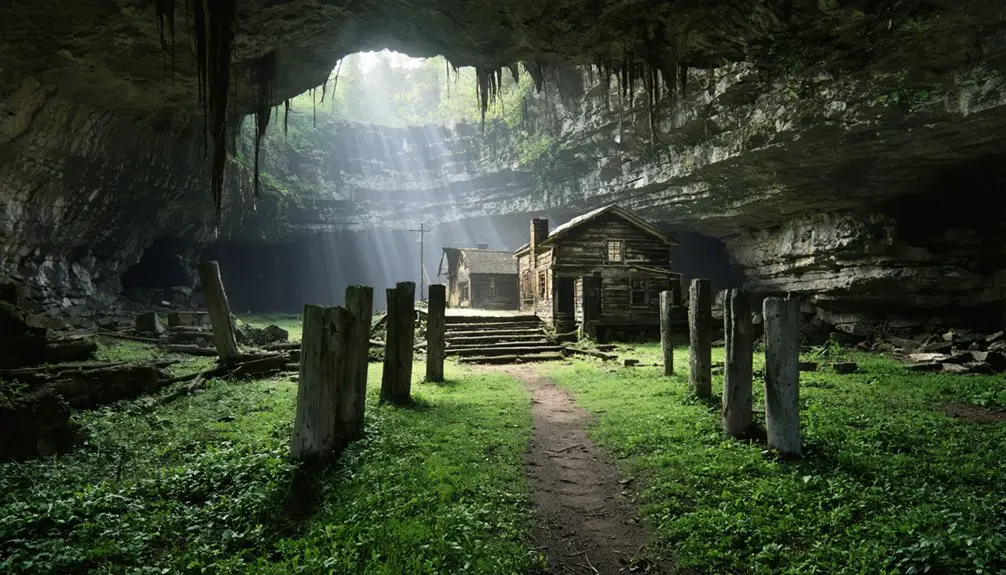
Beneath the pastoral landscape of West Virginia, Lobelia Saltpeter Cave harbors a dark history that intertwines colonial-era mining with modern tragedy.
In the 1980s, this cave, once essential for saltpeter mining during colonial times and the Civil War, became the site of a chilling murder. You’ll find that Walter Smith’s body was discovered by local children, buried under rocks by a man named Peter, who later confessed to the killing.
The West Virginia State Police collaborated with local cavers to recover Walter’s remains in 1986.
Today, the cave stands as a monument to both industrial heritage and human darkness. While artifacts from its saltpeter mining days have been relocated to protect them from vandalism, the cave’s complex legacy lives on through conservation efforts and the tight-knit caving community’s stewardship.
Physical Remnants and Natural Reclamation
If you visit Lobelia today, you’ll find the abandoned buildings slowly succumbing to the elements, with wooden structures gradually decaying and stone foundations settling into the earth.
Nature’s persistent advance has transformed the once-bustling mining community into a haunting tableau, where vines creep up weathered walls and saplings push through forgotten floorboards.
The surrounding forest has steadily reclaimed its territory, leaving only scattered remnants of human habitation amid the encroaching wilderness.
Abandoned Buildings Decay Slowly
While many ghost towns experience rapid structural collapse, Lobelia’s abandoned buildings tell a different story through their gradual decay. You’ll find unique decay patterns where nature slowly reclaims these structures, preserving a snapshot of rural West Virginia life. The buildings maintain surprising structural integrity despite decades of abandonment.
The town’s preservation stems from three key factors:
- Limited human interference allows natural decay processes to progress slowly.
- Local building materials like sturdy stone foundations resist complete deterioration.
- West Virginia’s climate creates a controlled breakdown rather than sudden destruction.
You can observe this preservation through weathered wood, peeling paint, and crumbling masonry – each telling its own story of time’s passage.
Wildlife now inhabits these spaces, adding another layer to their ongoing transformation.
Nature Reclaims Historic Structures
As nature steadily reclaims Lobelia’s historic structures, you’ll witness an intricate dance between the remnants of human habitation and the persistent force of natural succession.
Nature’s persistence reveals itself through moss-covered foundations, trees piercing through weathered roofs, and vines engulfing crumbling walls.
You’ll find stone chimneys and walls standing defiant against urban decay, while wooden structures succumb to the elements.
Root systems slowly crack foundations, and seasonal changes amplify the destruction – freeze-thaw cycles widen fissures while rain accelerates rot.
Throughout the site, you’ll spot rusted mining equipment partially hidden by advancing vegetation.
The town’s namesake wildflowers join maples and poplars in transforming the landscape, as wildlife returns to establish new habitats among the ghostly remains of this once-bustling coal community.
Legacy of an Appalachian Ghost Town
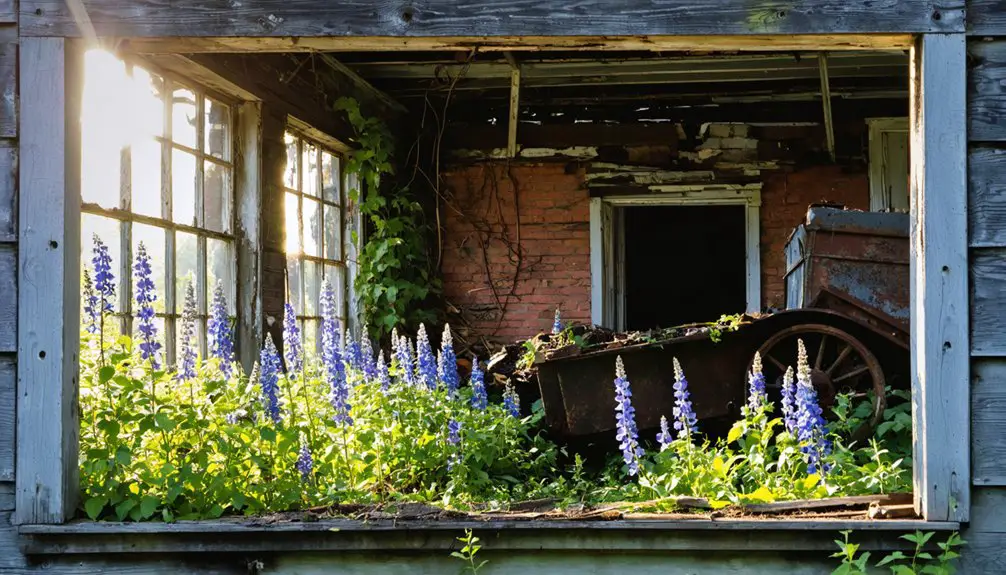
Today’s decaying remnants of Lobelia tell a complex story of Appalachian transformation, where abandoned structures and overgrown pathways mark the intersection of multiple American narratives.
You’ll find evidence of community resilience in Lobelia’s layered history, from indigenous roots to the influx of counterculture seekers in the 1970s.
The town’s cultural preservation exists in the stories of those who sought refuge from urban chaos, creating a unique blend of traditional and alternative lifestyles.
Here’s what makes Lobelia’s legacy particularly compelling:
- It represents the broader pattern of Appalachian economic shifts from mining to abandonment.
- The town served as a crucible where back-to-the-land movements met local traditions.
- Its remnants, including the infamous Saltpeter Cave, continue to draw historians and adventurers seeking to understand rural America’s transformation.
Frequently Asked Questions
Can Visitors Legally Explore the Abandoned Buildings in Lobelia Today?
Like a steel trap, ghost town exploration has legal boundaries you can’t ignore. You’ll need explicit owner permission to legally enter abandoned buildings, as trespassing laws strictly protect private property.
What Native American Tribes Originally Inhabited the Lobelia Area?
While Native history in the area spans thousands of years, you’ll find archaeological evidence of Fort Ancient farmers, followed by influences from Shawnee, Cherokee, and Delaware tribes of cultural significance.
Are There Any Seasonal Festivals or Events Near Lobelia?
Like sap flowing through mountain veins, you’ll find rich local traditions at Mountain State Maple Days, plus WV Enduro bike races, farmers’ markets, and ArtSpring Festival throughout the seasons near you.
How Accessible Is Lobelia During Winter Months?
You’ll find winter accessibility severely limited due to snow conditions, hazardous roads, and minimal maintenance. Don’t attempt visits without a 4×4 vehicle and extensive winter driving experience.
Do Any Descendants of Original Lobelia Residents Still Live Nearby?
You’ll find some descendant connections in surrounding Pocahontas County communities, though local history suggests most original families relocated during the 1960s-70s when new settlers arrived in the region.
References
- https://caves.org/wp-content/uploads/Publications/journal-of-spelean-history/154.pdf
- https://www.youtube.com/watch?v=-EeLwLa2t90
- https://longreads.com/2020/01/21/in-pocahontas-county-deep-divisions-and-a-gruesome-discovery/
- https://kids.kiddle.co/List_of_ghost_towns_in_West_Virginia
- https://en.wikipedia.org/wiki/Lobelia
- https://www.legendsofamerica.com/west-virginia-coal-mining/
- https://minesafety.wv.gov/historical-statistical-data/mining-in-west-virginia-a-capsule-history/
- https://coalheritage.wv.gov/coal_history/Pages/Birth-of-the-Industry.aspx
- https://www.wvgs.wvnet.edu/www/geology/geoldvco.htm
- https://www.nps.gov/articles/000/introduction-to-the-west-virginia-mine-wars.htm
